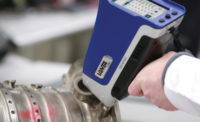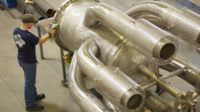It’s a fairly regular conversation. A contact calls in to discuss the potential of handheld X-ray fluorescence analyzers to solve a testing goal. It may be alloy analysis, hazardous substance screening, geological testing, or any number of applications that handheld XRF is a solution for. After a brief conversation, the contact understands the general capabilities of XRF and we have identified the correct analyzer configuration to meet their testing goals. Then the conversation turns to analyzer pricing…
Portable XRF prices can vary greatly depending on the configuration best suited to meet a testing goal, with systems typically landing anywhere from the high teens to mid-thirties (thousands of dollars). Many contacts don’t realize that a relatively small piece of nondestructive testing equipment will require a relatively substantial investment.
Now realizing the potential cost of acquisition, the conversation will typically lead down two different paths of continued discussions. Some contacts realize a potentially large frequency of use and decide to start the long road of cost justification. While the other realization many contacts have at this point is that their need is a relatively short lived one, maybe a single project or business opportunity that would not justify the full investment into XRF technology.
When the timetable of required testing is a short one, the discussion turns to XRF rentals. Handheld X-ray fluorescence analyzers are an excellent solution for many testing needs and the opportunity to rent systems for short-term requirements has become extremely popular. In addition to single project applications, many organizations will target the short term use of a system as they test new markets or generate enough business to make the full investment in the technology.
One recent renting organization was a testing laboratory that needed to demonstrate XRF capability in order to add lead (Pb) and RoHS screening to their scope of accreditation.
Even when the price conversation turns to the cost justification of X-ray fluorescence, rental options may still be of great interest. Many rental plans offer the option to credit a portion of the rental fee, if not all of it, towards the purchase price of a new unit. While a few hours of a sales demonstration is helpful, a one week rental with credit option provides interested organizations several benefits in the justification and decision process. Renting, which acts as a long-term trial in these situations, provides an opportunity to use the technology for an extended period of time and in the actual work environment. Users can collect real data, process reports, identify the work flow fit of the technology, and begin to build a case for the long-term investment.
Equipment Rental in Action
A recent example of using the option of equipment rentals to justify the purchase was seen from an organization that had a single application requirement. XRF technology can cover a large spectrum of applications and most interested organizations look for every possible use to help justify the investment. This particular manufacturing facility, however, had a single testing need: to quickly identify any Chromium contamination in powders they work with. After confirming instrument performance, the contact realized that the only way to receive budget approval was to collect real data with a system and show how the spectrometer would benefit their organization by allowing for in-house testing that was fast and reliable.
Associates worked with the client to coordinate a one-month rental of a system configured for their single application use. After the rental, the primary contact felt confident that they had the information needed to make the argument for the return on investment that a system would provide. Part of the rental agreement allowed for a tiered credit to purchase option based on when an order was placed. While the client wasn’t able to place the order in time to receive full rental credit, they did hit the second tier and are now utilizing handheld XRF on a daily basis.
Prior to the development of handheld X-ray fluorescence analyzers, it was possible to rent X-ray fluorescence technology for short term testing interests. However, those rentals were the larger desktop models and came with several negatives that made it a less than optimal process. A major issue with renting desktop systems has always been the cost and time involved in shipping. Handheld analyzers offer the benefit of speed and cost savings since they can be shipped overnight at a very low cost. A second issue with renting desktop analyzers was that they required a technician to provide on-site installation and training (again, additional cost and time). To various degrees, most handheld analyzers are typically ready to use out of the box with minimal training. In fact, the software of most handheld analyzers is typically so streamlined that after a simple phone or webcam training session a renter will be taking measurements and developing customized reports.
Most organizations that offer handheld XRF rentals will do their best to make the rental process a simple one. Rental programs can be as simple as only requiring a signed agreement, an order for the rental amount, and the renter’s shipping account information. While customized rental periods are available, the standard plans include daily, weekly and monthly options. Most rental periods begin the day a system is received at the renter’s facility and extend by calendar day (i.e. seven days for a week rental) until the end of the rental period.
Portable X-ray fluorescence rentals are available from a variety of sources. Most manufacturers will have some form of rental program set up and many of their distributors will offer the same, or similar plans. There are also a number of third party organizations that either rent a variety of testing equipment or offer the use of their own system while it is not in use.
With many sources of XRF rentals, it is important to consider a few factors when selecting where to rent test equipment from. One of the most critical factors should be the support that will be available before and during the rental period. Are they familiar enough with the hardware and software of the analyzer to help quickly and efficiently? Additionally, if an organization takes too long to respond to your request to rent, how will they respond when you need support during the rental? It is also important to consider instrument availability and the version of the system one will receive. Why rent an older version when you could have an analyzer with the latest technological developments?
The development of handheld X-ray fluorescence has expanded the application reach of this very beneficial testing technology. Now, the growth of rental programs is expanding the reach of the systems as a whole by allowing organizations that may not have the budget for a full investment the opportunity to apply the technology for their testing goals.




